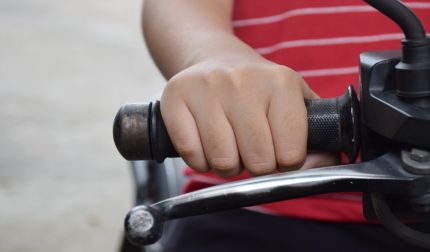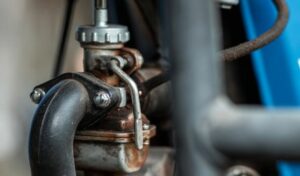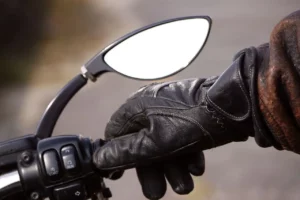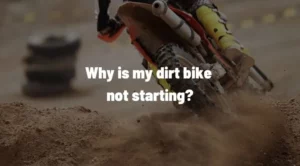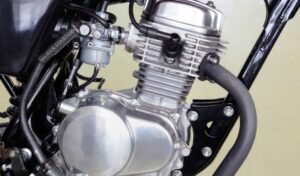Motorcycles represent freedom, adventure, and the thrill of the open road. This dream can become a nightmare if the throttle gets stuck. A stuck throttle makes it difficult to control your motorcycle’s speed, which can be dangerous. It’s a pressing issue. This article will explain how to safely and effectively fix a motorcycle’s stuck throttle.
Let’s start with the basics before we fix a stuck throttle. Motorcycle engines are controlled by the throttle. It’s usually a handlebar-mounted lever. The throttle controls the engine’s air-fuel mixture and speed. Grime, lack of lubrication, or mechanical failures like cable or spring damage can cause a throttle to stick. A stuck throttle can make your motorcycle dangerous and unpredictable.
Symptoms of a Stuck Throttle
A stuck throttle may exhibit several symptoms. If your motorcycle accelerates after releasing the throttle or idles at high RPMs, your throttle may be stuck. If the throttle grip is hard to twist or doesn’t return to its original position, it may be stuck and if you see these signs, don’t ride the bike until you fix it.
Stuck throttles can make your motorcycle uncontrollable and dangerous. Common symptoms of a stuck throttle:
1. Difficulty in Throttle Operation:
One of the first signs you may notice is a stiffness or resistance when you try to twist the throttle grip. If you feel it’s harder to twist than usual, or it doesn’t spring back as quickly, your throttle might be sticking.
2. Continued Acceleration:
If you release the throttle but your motorcycle continues to accelerate or maintain its speed, that’s a clear indication of a stuck throttle. In a normal functioning motorcycle, the speed should gradually decrease when you let go of the throttle.
3. High Idle Speed:
When your motorcycle’s engine runs faster than it should while idle, it’s often a sign of a stuck throttle. High idle RPMs (revolutions per minute) suggest that the throttle is not closing completely, allowing more fuel-air mixture into the engine than necessary.
4. Irregular Throttle Response:
If your motorcycle suddenly speeds up or slows down without any input from you, or if the throttle doesn’t respond immediately to your inputs, it could mean your throttle is sticking.
5. Physical Damages:
Check the throttle cable and housing for any visible signs of damage, like fraying or kinks in the cable. These damages could impede the smooth operation of the throttle.
If you notice any of these signs, it’s important to avoid riding the motorcycle until you have resolved the issue, as a stuck throttle can lead to dangerous situations. Always prioritize safety when operating any motor vehicle.
Tools Needed to Fix a Stuck Throttle
Repairing requires proper tools. This process requires a screwdriver set, pliers, wrench set, lubricant, and cleaning supplies like a cloth and brush. Screwdrivers remove screws, pliers hold, and wrenches turn nuts and bolts. Lubrication reduces throttle friction.
Step-by-Step Guide: Loosening a Stuck Throttle
Start by wearing protective gear and working in a well-ventilated area.
1. Safety First
Start with gloves and safety glasses. Work in a well-ventilated, well-lit space.
Step 2: Determine the Issue
Check the throttle grip and cable to determine the issue. Try twisting the throttle. The handlebar mechanism is causing the grip to stick. If the grip rotates but the motorcycle doesn’t respond, the cable or carburetor linkage is faulty.
Step 3: Remove Throttle Casing
Remove the handlebar throttle casing with a screwdriver. When the screws are removed, this casing splits into two halves.
Step 4: Check and Lubricate
Check the throttle grip and inner handlebar for grime. Clean and lubricate with a clean cloth. The throttle grip should rotate freely.
Step 5: Check Throttle Cable
The throttle cable may be the issue if the throttle grip moves freely. Remove the throttle grip cable. Check for cable kinks and frays. Replace damaged cables.
Step 6. Lubricate Cable
Lack of lubrication may cause throttle cable sticking. Using a cable lubricator tool and a suitable lubricant, thoroughly lubricate the cable. Attach the lubricator to the cable end and spray until it comes out the other end.
Step 7. Reconnect Cable
Reconnect the throttle grip cable after lubricating. Check the cable’s movement and security.
Step 8. Test
Twist the grip several times to test throttle action after reconnecting the throttle cable. It should move smoothly and reset when released.
If you’re unsure or uncomfortable, take your motorbike to a mechanic. Prioritize safety.
Cleaning the Throttle Components
Proper cleaning is crucial to ensure smooth throttle operation.
- Clean the Handlebar and Throttle Grip: Use a mild detergent and water to clean any dirt or grime. Dry thoroughly before reassembly.
- Clean the Cable: Use a cable cleaner to clean the inside of the cable. Ensure it’s completely dry before applying lubricant.
- Clean the Carburetor Linkage: This is where the other end of the cable is attached. Clean it carefully, ensuring no debris is left inside.
Reassembling the Throttle
After cleaning and lubrication, it’s time to reassemble the throttle.
- Reconnect the Cable: Connect the throttle cable back to the throttle grip and the carburetor linkage. Ensure that it operates smoothly.
- Reattach the Throttle Casing: Screw the throttle casing back onto the handlebar. Make sure it’s not too tight to prevent the throttle grip from sticking again.
- Test the Throttle: Twist the throttle grip a few times to confirm that it’s moving freely and returning to its original position.
Testing Your Motorcycle Post-Repair
Safety is paramount. Before hitting the road, test your motorcycle in a safe, controlled environment. Twist the throttle and let it go several times to ensure it’s not sticking. Ride around slowly, testing the throttle response. Listen for any abnormal sounds and pay attention to any unusual feel in the throttle response. If everything checks out, you’re ready to ride freely once more.
Fixing A Stuck Throttle, How Can I Avoid Mistakes?
Correctly fixing a motorcycle throttle can be easy. However, several common mistakes during the process could worsen the problem. Avoid these mistakes:
1. Forcing the Throttle: Trying to force a stuck throttle is a big mistake. Throttle system damage may result.
Avoidance Tip: Tight throttles require patience. If it doesn’t move freely, it may need cleaning, lubrication, or replacement.
2. Using the Wrong Tools or Lubricant: Using the wrong tools or lubricants can damage the motorcycle’s parts.
Avoidance Tip: Start with the right tools. Use a motorcycle-specific oil or grease for throttle components.
3. Ignoring Cable Damage: Throttle cables can fray or kink. Ignoring this damage and lubricating the cable can cause future problems.
Avoidance Tip: Always inspect the throttle cable. If damage is found, replace the cable.
4. Incorrect Reassembly: Reassembling the throttle incorrectly after cleaning or lubrication can cause it to stick again or cause other issues.
Avoidance Tip: Before starting, note how the throttle is assembled so you can reassemble it correctly. Check your motorcycle’s manual or ask a professional.
5. Neglecting Regular Maintenance: Regular maintenance can prevent throttle issues like stuck throttles, but many people neglect it.
Avoidance Tip: Maintain your throttle system. This will keep it running smoothly and prevent issues.
By avoiding these mistakes, you can fix a stuck throttle and avoid future problems.
Preventive Measures to Avoid a Stuck Throttle
Preventive measures can save you from unexpected breakdowns and potential accidents. Regularly inspect your throttle mechanism for any signs of wear or damage. Lubricate the throttle components periodically. Avoid exposing your motorcycle to excessive moisture or dirt, which can accelerate wear and tear. Regular maintenance is the key to a smoothly operating throttle.
When to Consult a Professional
DIY repairs are rewarding and cost-effective, but they’re not always best. If you’re unsure of your abilities or the throttle problem persists despite your best efforts, consult a professional. A qualified motorcycle mechanic can diagnose and fix the issue. The mechanic’s rates and problem severity will determine the cost.
Frequently Asked Questions
A stuck throttle can be caused by various factors such as grime or dust build-up, lack of lubrication, or mechanical issues like a damaged or frayed cable, broken return spring, or an issue with the carburetor linkage.
Riding with a stuck throttle can lead to dangerous situations. A motorcycle with a stuck throttle can continue to accelerate uncontrollably or fail to decelerate, leading to potential accidents.
Basic tools you would need include a set of screwdrivers, pliers, wrenches, lubricant, and cleaning materials. Always ensure to use motorcycle-grade lubricant for the throttle components.
Use a mild detergent and water to clean the handlebar and throttle grip. A cable cleaner can be used for the cable, and the carburetor linkage should also be cleaned thoroughly. After cleaning, make sure all parts are dried completely to avoid rusting or corrosion.
While it may seem manageable, it is not advisable to ride with a sticking throttle. It can lead to unpredictable speed changes and potential accidents. Always prioritize safety.
Regular maintenance is key. This includes periodic cleaning, proper lubrication, and timely replacement of worn-out parts. Also, storing your motorcycle in a clean, dry place can prevent grime and dust build-up.
Conclusion
A stuck throttle can turn a fun ride into a dangerous situation. But with this comprehensive guide, we hope you feel confident in diagnosing and fixing a stuck throttle. Remember, regular maintenance can prevent many common motorcycle issues. Always prioritize safety and don’t hesitate to seek professional help when necessary. Happy riding!
